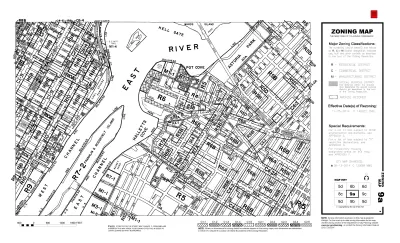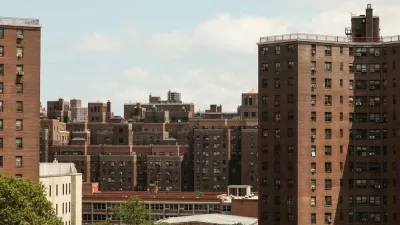According to Seymour Toll's 1969 book, New York City's 1916 zoning code was less a civic-minded project than an attempt to protect elite retail districts from the riff-raff. The ramifications for American zoning at large are significant.

For a short time during the late 1960s, Jake Blumgart writes, "zoning received the attention it deserved as a monumental force shaping the character of many American communities—in large part due to civil rights protests over its exclusionary effects in newer suburbs." Today, renewed debate about urban segregation has cast zoning into the spotlight once again.
In his 1969 book Zoned American, Seymour Toll gives us "an in-depth history of the 1916 New York code, the progenitor of zoning codes nationwide, and the impetus for its creation. The received history of zoning often frames it as a creation of Progressive-era good government planners. But Zoned American shows that the code was actually created as a weapon to defend the narrow self-interest of a small group of prestigious merchants."
In a move that presages problematic zoning later in the century, "wealthy retailers based along Fifth Avenue were the advance guard of zoning in New York. Dubbed the Fifth Avenue Association, they believed their investments would be compromised by the northward advance of the garment industry and the hordes of foreign born workers that accompanied it."
The zoning that emerged from these conditions had specific and recognizable prejudices. It sought to constrain density and height, separating uses to preserve "the northern stretch of Fifth Avenue—and Manhattan more generally—for businesses that catered to the wealthy."
Stephen Smith, well-known as the voice behind @MarketUrbanism on Twitter, remarked, '"There wasn't some grand plan, zoning was taking whatever was there and freezing it [...] Toll convinced me it wasn't really planning, it was just reacting to whatever was already built.'"
FULL STORY: Learning from 'Zoned American'

Planetizen Federal Action Tracker
A weekly monitor of how Trump’s orders and actions are impacting planners and planning in America.

The Simple Legislative Tool Transforming Vacant Downtowns
In California, Michigan and Georgia, an easy win is bringing dollars — and delight — back to city centers.

San Francisco's School District Spent $105M To Build Affordable Housing for Teachers — And That's Just the Beginning
SFUSD joins a growing list of school districts using their land holdings to address housing affordability challenges faced by their own employees.

In More Metros Than You’d Think, Suburbs are Now More Expensive Than the City
If you're moving to the burbs to save on square footage, data shows you should think again.

The States Losing Rural Delivery Rooms at an Alarming Pace
In some states, as few as 9% of rural hospitals still deliver babies. As a result, rising pre-term births, no adequate pre-term care and "harrowing" close calls are a growing reality.

The Small South Asian Republic Going all in on EVs
Thanks to one simple policy change less than five years ago, 65% of new cars in this Himalayan country are now electric.
Urban Design for Planners 1: Software Tools
This six-course series explores essential urban design concepts using open source software and equips planners with the tools they need to participate fully in the urban design process.
Planning for Universal Design
Learn the tools for implementing Universal Design in planning regulations.
Smith Gee Studio
City of Charlotte
City of Camden Redevelopment Agency
City of Astoria
Transportation Research & Education Center (TREC) at Portland State University
US High Speed Rail Association
City of Camden Redevelopment Agency
Municipality of Princeton (NJ)





























